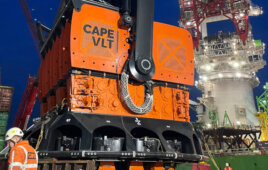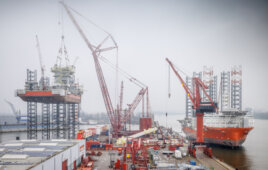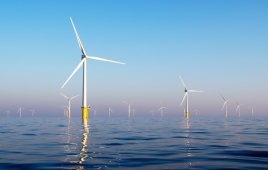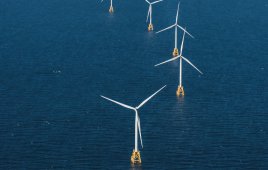This article comes from the Journalist’s Resource and was authored by Leighton W. Klein
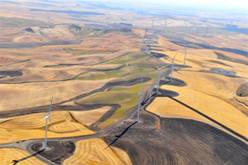
More projects like this one by First Wind will start construction in 2013, thanks to the passage of the Production Tax Credit.
When the House of Representatives approved the Senate’s emergency “fiscal cliff” deal on New Year’s Day 2013, one of the winners was the U.S. wind-power industry. The production tax credit of $0.022/kWh was renewed, which has the effect of making wind power more competitive with fossil fuels.
Even working within the more restrictive context of previous bills, wind energy is the fastest growing of all renewables. Among all energy sources, it is second only to natural gas in terms of added capacity in recent years. Wind represented 32% of the electrical-generation capacity added in 2011, with about 6.8 GW of new capacity and $14 billion invested. As of that year, wind generated nearly 3% of the country’s electricity, second among renewable sources only to hydropower, which has shown little growth since the 1970s.
The potential for offshore wind is considerably higher. According to the DoE, untapped offshore wind alone could provide four times the nation’s current generation capacity. While land-based wind has lagged up to now, a wide range of new projects are under study and development, including Cape Wind in Massachusetts. The project was awarded a15-year contract to provide the local utility with more than a quarter of its power, and officiallybroke ground in August 2012 at its New Bedford production facility.
As wind energy has grown, so have the number of jobs it provides — 85,000 workers were employed in 2008 and 2009, and the production tax credit’s renewal will now keep many on the job who would otherwise have been laid off. Much of the equipment installed is also built in the United States: According to the Department of Energy, 70% of the equipment at U.S. wind farms was manufactured domestically, double the percentage in 2005.
To grow consistently, analysts say, what’s needed is stable regulatory context, something currently lacking in the United States. The booms and busts have been driven by the erratic extension and expiration of the production tax credit — in large part 2012′s banner year, with12 GW of new capacity, was driven by the fear that Congress wouldn’t renew the credit: Projects had to be completed and online by the end of the year or they wouldn’t qualify. In a step forward, the wind-energy provision in the “fiscal cliff” deal only requires that projects start construction in 2013, not go on-line, to receive the credit.
Research indicates that the long-term prospects for wind are significant. A study commissioned by the Department of Energy determined that wind will generate 20% of the nation’s electricity by 2030. Looking farther ahead, a 2009 Harvard study calculated that even under conservative assumptions, a combination of onshore and offshore wind could generate 16 times current domestic electrical consumption. And a study in PNAS, “Saturation Wind Power Potential and Its Implications for Wind Energy,” determined that “there is no fundamental barrier to obtaining half (about 5.75 TW) or several times the world’s all-purpose power from wind in a 2030 clean-energy economy.”
The following reports and studies provide further perspective:
“2011 Wind Technologies Market Report” (PDF)
Wiser, Robert; Bolinger, Mark; et al. U.S. Department of Energy, Lawrence Berkeley National Laboratory, 2011.
Conclusion: “Regardless of future uncertainties, wind power capacity additions over the past several years, as well as the additions predicted for 2012, have put the United States on a trajectory that may lead to 20% of the nation’s electricity demand coming from wind energy by 2030. In May 2008, the U.S. Department of Energy, in collaboration with its national laboratories, the wind power industry, and others, published a report that analyzed the technical and economic feasibility of achieving 20% wind energy penetration by 2030 (DOE 2008)…. Historical growth over the last six years puts the United States on a trajectory exceeding this deployment path, a trend that is anticipated to continue in 2012.”
“Offshore Wind Market and Economic Analysis” (PDF)
Hahn, Michael; Gilman, Patrick. U.S. Department of Energy, Navigant, November 2012.
Conclusion: “Policy examples from other countries have shown that proper policy designs can stimulate offshore wind markets, and in turn, offshore wind markets can have a significant impact on economic development throughout the U.S. The analysis showed that in the high-growth scenario, the U.S. offshore wind industry could support [approximately] 350,000 FTEs in 2030, and 50,000 FTEs in the low-growth scenario. Policies that can direct the market toward the higher growth scenario can therefore have a large benefit to the U.S. economy.”
“Global Potential for Wind-generated Electricity”
Lu, Xi; McElroy, Michael B.; Kiviluomac, Juha. PNAS, July 2009, Vol. 106, No. 27. doi: 10.1073/pnas.0904101106
Abstract: “The potential of wind power as a global source of electricity is assessed by using winds derived through assimilation of data from a variety of meteorological sources. The analysis indicates that a network of land-based 2.5-megawatt (MW) turbines restricted to nonforested, ice-free, nonurban areas operating at as little as 20% of their rated capacity could supply >40 times current worldwide consumption of electricity, >5 times total global use of energy in all forms. Resources in the contiguous United States, specifically in the central plain states, could accommodate as much as 16 times total current demand for electricity in the United States. Estimates are given also for quantities of electricity that could be obtained by using a network of 3.6-MW turbines deployed in ocean waters with depths <200 m within 50 nautical miles (92.6 km) of closest coastlines.”
“Saturation Wind Power Potential and Its Implications for Wind Energy”
Jacobson, Mark Z.; Archer, Cristina L. PNAS, September 2012, Vol. 109, No. 39. doi: 10.1073/pnas.1208993109.
Abstract: “Wind turbines convert kinetic to electrical energy, which returns to the atmosphere as heat to regenerate some potential and kinetic energy. As the number of wind turbines increases over large geographic regions, power extraction first increases linearly, but then converges to a saturation potential not identified previously from physical principles or turbine properties. These saturation potentials are >250 terawatts (TW) at 100 m globally, approximately 80 TW at 100 m over land plus coastal ocean outside Antarctica, and approximately 380 TW at 10 km in the jet streams.”
Filed Under: Construction, News, Policy

